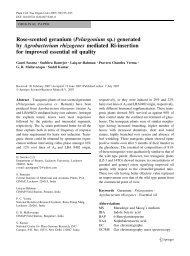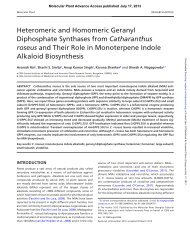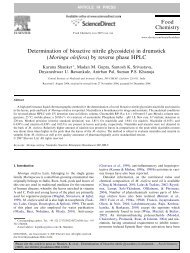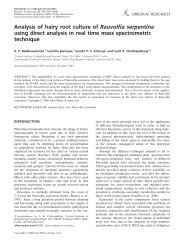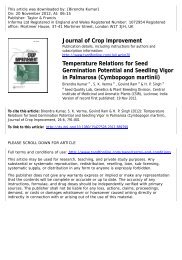Volume 2. Issue 1. ISSN 1555-9475 (online) www ... - CIMAP Staff
Volume 2. Issue 1. ISSN 1555-9475 (online) www ... - CIMAP Staff
Volume 2. Issue 1. ISSN 1555-9475 (online) www ... - CIMAP Staff
- No tags were found...
You also want an ePaper? Increase the reach of your titles
YUMPU automatically turns print PDFs into web optimized ePapers that Google loves.
96 Natural Product Communications Vol. 2 (1) 2007 Misra et al.Table 1 (Continued)CTG/ACA 157,158,325 108,187,353 104,111,118,129,150,153,163,356, 189372,392CTG/AGG 324,325 - 114,134,152,190,211,245,267,361 268CTG/ACG 106,158,268,302,337 398 287 321,393CTT/ACA 130,189,388 119 235,263,341 223,224,330,331CTT/ACC - 328 299,303 335CTT/AGG 120, 175,347,385 266,317 146,330,331CTT/ACG 189 367 147,148,149,150 329,333,335drug supposedly consisting of a particular population.The frequency of the occurrence of these uniquebands in the analysis of the DNA isolated from thecrude drug preparation could be used as an assay forthe presence of a specific population in it. This couldhelp in quantification of the adulteration of the crudedrug of different species. This will go a long way inestablishing the authenticity and credibility of theayurvedic drug ‘Safed Musli’, which presentlysuffers from the problem of adulteration. Theprincipal component of this drug, A. adscendens, ismainly responsible for the aforementionedtherapeutic properties. However, the presence ofother Chlorophytum species in the crude drug mayalter its efficacy and therapeutic value. Althoughthere has been no study on the deleterious effects ofthe adulterants on human beings, there is a distinctpossibility that they may be harmful for humanusage. The importance of the present study stemsfrom the fact that it provides an authentic tool todetect adulterants in the crude drug ‘Safed Musli’ andvalidates the scientific basis of this drug in Ayurveda.ExperimentalPlant material: The plant material used in this studyconsisted of diverse collections of Asparagusadscendens, Chlorophytum borivilianum, C.arundinaceum and C. tuberosum taken from the<strong>CIMAP</strong> gene bank. For each of the four samples, leafmaterial pooled from the respective populations wasused for DNA isolation (20 plants in each species).DNA isolation: DNA was isolated using the protocoldescribed by Khanuja et al. [4] and quantified byfluorimetry using a DyNa Quant 200 fluorimeter.AFLP analyses: For AFLP analysis, DNA wasrestricted using two restriction endonucleases, EcoRIand Tru9I (an isoschizomer of MseI), and doublestrandedadapters were ligated to the ends of DNAfragments, generating templates for subsequent PCRamplifications (preselective followed by selective).Restriction and ligation reactions were carried outsimultaneously in a single reaction [5]. To carry outthe reaction, an enzyme master mix for 10 reactionswas prepared containing 1μL 10X T4 DNA ligasebuffer, 1μL 0.5 M NaCl, 0.5μL 1 mg/mL BSA, 1μLTru9I (10 U/μL), 4.25μL EcoRI (12 U/μL), 0.5 μLT4 DNA ligase (20 U/μL, high concentration) and<strong>1.</strong>75 μL water. The restriction-ligation reactionconsisted of 300 ng of DNA (5.5 μL), 1 μL 10X T4DNA ligase buffer, 1 μL 0.5 M NaCl, 0.5 μL 1mg/mL BSA, 1 μL MseI adaptors (AppliedBiosystems), 1 μL EcoRI adaptors (AppliedBiosystems) and 1 μL enzyme master, as describedabove. The reaction mix was incubated overnight atroom temperature and subsequently diluted 20-foldwith T 10 E 0.1 (10 mM Tris and 0.1 mM EDTA) buffer.The ligated adaptors served as primer binding sitesfor a low-level selection in the preselectiveamplification of restriction fragments. The MseIcomplementary primer had a 3’-C and the EcoRIcomplementary primer a 3’-A. Only the genomicfragments having an adaptor on each end amplifiedexponentially during the PCR. The preselectiveamplification mix was prepared by adding 4 μL of20-fold diluted DNA from the restriction-ligationreaction, 0.5 μL AFLP preselective primer (EcoRI,Applied Biosystems), 0.5 μL AFLP preselectiveprimer (MseI, Applied Biosystems), and 15 μL AFLPcore mix. The preselective amplification was carriedout in a thermal cycler programmed as: 72°C for2 min; 20 cycles of 94°C for 20 sec, 56°C for 30 secand 72°C for 2 min; 60°C for 30 min; and 4°C forinfinity.The preamplified DNA was diluted 20-fold withT 10 E 0.1 buffer and selective amplifications werecarried out using different MseI and EcoRI primercombinations (Applied Biosystems). Primers chosenfor the amplification were from 16 available AFLPselective primers (8 fluorescently tagged EcoRI and8 untagged MseI primers). The EcoRI primerscontain 3 selective nucleotides with the sequence 5’[Dye-Primer-Axx]-3’, while the MseI primers had the3 selective nucleotides starting with C with thesequence 5’ [Primer-Cxx]-3’. Selective amplificationof each sample was done with all the 64 (8x8)-primercombinations (MseI/EcoRI) using multiplex-PCR





